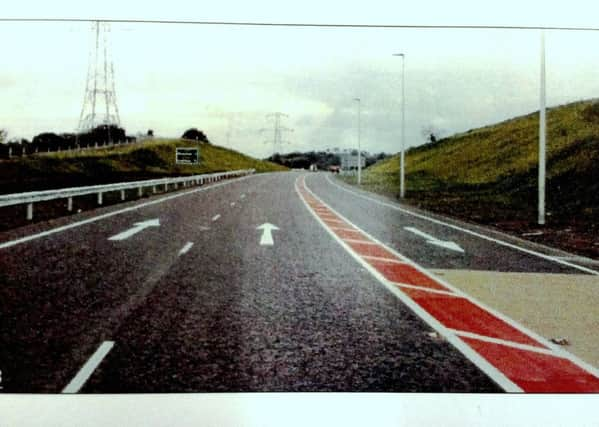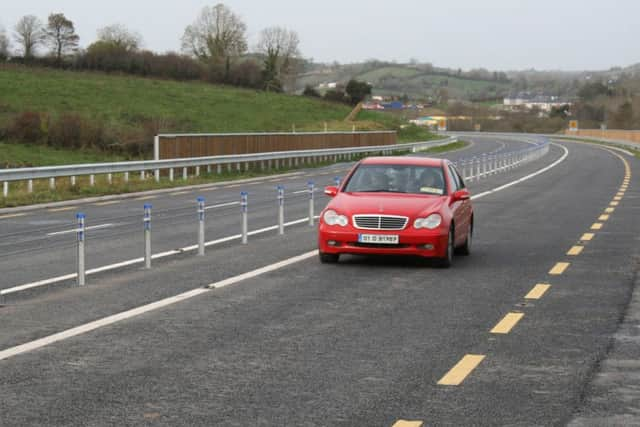Ben Lowry: The new Magherafelt bypass has lanes for overtaking, as all such roads should


Anyone who has been in the Co Londonderry town knew how congested it was, and how much it needed to have through traffic removed from its centre.
The £35 million road seems to have been designed to a high standard.
Advertisement
Hide AdAdvertisement
Hide AdAs I understand it, two thirds of the new road – 4km out of the 6km total – will have a so-called 2+1 layout.


See the picture at the top of this page to get a sense of what that means. The road has two lanes for traffic heading one way, and one lane the other way.
Another way to describe it is overtaking lanes.
In parts of Europe (including Monaghan, on a stretch of the N2 at Castleblaney, a road that ultimately leads on to the A5 in Co Tyrone) there have been roads built with that 2+1 design on their whole length.
It is an important innovation in road design, because it takes up less space than a dual carriageway or motorway, but nonetheless provides constant overtaking opportunities.
Advertisement
Hide AdAdvertisement
Hide Ad

The road is always three lanes wide, with two lanes of traffic in one direction, and one in the other. The direction of the two-lane stretches is always changing, meaning that even when you are on a single lane stretch, there is always an overtaking opportunity shortly ahead.
Such opportunities are one of the most important aspects of road design, because they slash death rates.
In a full long-distance 2+1 road, there is a barrier in the middle that means you cannot turn right. You cannot overtake until you reach a two-lane stretch.
Right turns on roads across traffic and overtaking in the face of oncoming traffic are two of the most dangerous manoeuvres on a road. Any driver (ie all) who has tried either a right turn or overtaking will know why.
Advertisement
Hide AdAdvertisement
Hide AdAs I get older I have become so cautious about overtaking that I have become one of those reticent people of whom I was so critical when I was a younger and faster driver: sitting behind, for example, a slow moving lorry until there is an unequivocally safe and clear point at which to overtake. Such opportunities can be rare on twisting rural routes in Northern Ireland.
I have reported on enough inquests and road deaths to fear that even extremely unlikely things will happen.
Consider, for example, that just as you are overtaking a teenager rapidly turns out of a driveway on your right, with them turning to their left on to the road without looking, assuming there will only be traffic on the main direction of the road. I have never seen such a thing happening and the chances of it are exceedingly rare but could mean instant death if it did.
This means that I am cautious about overtaking if there is so much as a laneway to the right when I am doing so.
Advertisement
Hide AdAdvertisement
Hide AdRoad deaths in Northern Ireland have fallen relentlessly over recent decades. By my calculations around 700 people would die on the roads in NI if 1970s death rates, per mile travelled, were applied to today’s traffic levels. In recent years between about 50 and 70 people have died each year, a staggering and wonderful fall.
There are many reasons for the improvement, ranging from seat belt laws to better designed cars to much stricter speed enforcement. But better roads, particularly dual carriageways and motorways, are a major factor in cutting fatalities.
A 2+1 road is the next best thing, and it is good that the Magherafelt road has been designed in that way. It is a pity, however, that the entire road is not to that design.
I believe that all bypasses now need to be at least 2+1 for their whole duration, and preferably a dual carriageway with a separated cycle lane.
Advertisement
Hide AdAdvertisement
Hide AdSuch routes are expensive, but as this column has often observed there is still a lot of extravagant public spending in NI, and some of it could be diverted to such road infrastructure, that lasts for a century or more (consider the Sydenham bypass, work on which began in the 1930s and which is still a fantastic road).
To get a sense of why a bypass should have overtaking opportunities, imagine driving for several miles behind a vehicle that you are loathe to overtake for a reason such as safety. If a single carriageway bypass is coming up, you will still be stuck behind the vehicle on the bypass. But if a dual carriageway or 2+1 bypass is ahead, you will be more relaxed about the delay, knowing that it will soon come to an end, and less inclined to take risks overtaking.
Given that we will one day be going to all the disruption and cost of building bypasses of places such as Ballynahinch in Co Down and Fivemiletown in Co Tyrone, we might as well make them as wide and long-lasting as possible.
This was not done in bypasses of Comber or Newtownards, among other places.
Advertisement
Hide AdAdvertisement
Hide AdOne of the most glaring examples of the failure was at Ballymoney. It would have greatly relieved driver frustration on the congested Frosses Road, for example, if motorists stuck behind slow moving vehicles had know they could overtake once they reached Ballymoney, but even when the bypass was built they were not given this opportunity.
It was not done in the 1996 bypass of Newry, and merely led to a later, and much more expensive dual carriageway bypass of the original bypass.
• Ben Lowry (@BenLowry2) is News Letter deputy editor